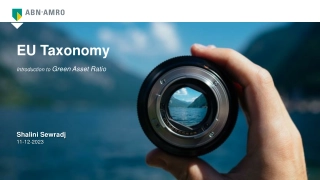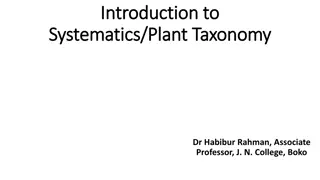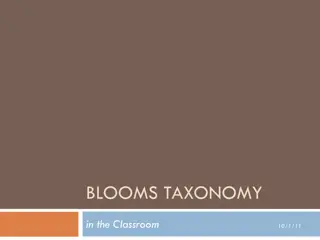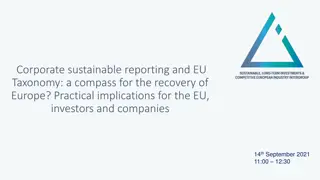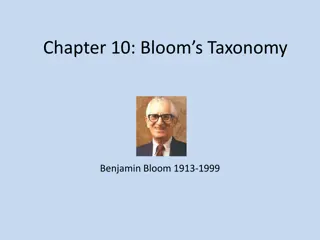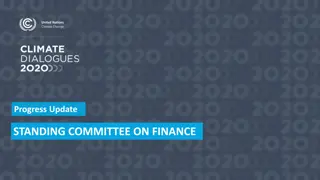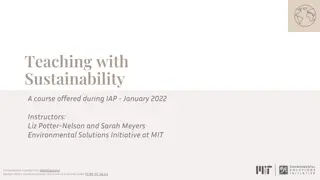Overview of Platform on Sustainable Finance and EU Taxonomy
Platform on Sustainable Finance focuses on six environmental objectives including climate change, circular economy, pollution prevention, and biodiversity protection. It emphasizes science-based, easy-to-use features to contribute sustainably without significant harm. The EU Taxonomy identifies activities for climate change mitigation and adaptation across various sectors like buildings, electricity generation, transport, and manufacturing. It helps companies transition to a greener economy by defining and increasing their share of green activities over time.
Download Presentation

Please find below an Image/Link to download the presentation.
The content on the website is provided AS IS for your information and personal use only. It may not be sold, licensed, or shared on other websites without obtaining consent from the author. Download presentation by click this link. If you encounter any issues during the download, it is possible that the publisher has removed the file from their server.
E N D
Presentation Transcript
PLATFORM ON SUSTAINABLE FINANCE
6 environmental interlinked objectives CLIMATE CHANGE Other objectives Transition to a circular economy Mitigation Pollution prevention and control Adaptation Sustainable use and protection of water and marine resources Protection and restoration of biodiversity & ecosystems Technical Screening Criteria under development Technical Screening Criteria in the Delegated Acts PLATFORM ON SUSTAINABLE FINANCE
Key features Science-based Leverage existing work Dynamic Turnover, Capex & Opex Easy to use Substantially contribute Do no significant harm Comply with Minimum safeguards To at least one of the six environmental objectives as defined in the proposed regulation To any of the other five environmental objectives as defined in the proposed regulation PLATFORM ON SUSTAINABLE FINANCE
EU Taxonomy First set of activities (from the first Delegated Acts that cover climate change mitigation & adaptation objectives) Buildings New, existing and renovations Supply chain / SMEs Electricity generation Solar, wind, geothermal, hydro, Gas only if with CCS Storage, Activites were prioritized as these sectors are responsible FOR OVER 80% of direct greenhouse gas emissions in the EU transmission Transport ICT Very low emissions, to zero tailpipe by 2025: electric, hydrogen Manufacturing Transitions Components Aluminium, Steel, Concrete, Plastics Forestry Maintaining carbon Improving carbon performance Energy efficiency, adaptation PLATFORM ON SUSTAINABLE FINANCE
EU Taxonomy use Companies: how it helps transition By defining green economic activities, not companies The Taxonomy enables companies to transition by gradually increasing their share of green activities Company XYZ Share of green activities 20% Based on share of turnover A B C D 2020 Factory A expands Taxonomy aligned investment (CAPEX) B A D C 50% 2025 Factory B increases energy efficiency Taxonomy aligned investment (CAPEX) A D B E 70% 2030 Factory C is closed - Factory E is built Site/project/operation that is Taxonomy-aligned Site/project/operation that is not Taxonomy-aligned PLATFORM ON SUSTAINABLE FINANCE
Key Terms for Reporting under the EU Taxonomy Eligible Activities Aligned Not Eligible Eligible Not Aligned Estimated Aligned PLATFORM ON SUSTAINABLE FINANCE
Key Timeline for Reporting under the EU Taxonomy Jan 2025 Jan 2023 Jan 2022 Jan 2024 Report Eligibility Non-financial corporate reporting of Alignment Financial corporate reporting of Alignment Inclusion of estimates in KPI PLATFORM ON SUSTAINABLE FINANCE
Whats included in Reporting for Financial Undertakings? Article 7(1): As general rule exposures to central governments, central banks and supranational issuers excluded from both numerator and denominator of the KPI. Article 9: Subject to review in mid-2024. Recital 13: Financial undertakings may, however, and on a voluntary basis, disclose exposures to taxonomy aligned bonds and taxonomy aligned debt securities that are issued by central governments, central banks or supranational issuers. Separately from the KPI. Local governments financing e.g., social housing, public transportation etc. shall be included in both numerator & denominator of the KPI (Eg, municipalities are included). PLATFORM ON SUSTAINABLE FINANCE
Voluntary Disclosures As general rule, the delegated act doesn t prohibit voluntary disclosures, provided they are reported separately from the KPIs. E.g., Estimated aligned reports may only be disclosed voluntarily, and separtely from the KPIs. E.g., Sovereign green bond exposures may only be disclosued voluntarily, and separtely from the KPIs. PLATFORM ON SUSTAINABLE FINANCE
KPIs for Banks (Credit Institutions) a main KPI for on-balance sheet assets stock, except sovereign exposures, related to the financing activities (Green Asset Ratio - GAR); additional GAR KPI (flow i.e. new loans); additional KPIs for off-balance sheet assets (FinGuar, AuM); an additional KPI for commissions and fees related to activities other than financing (starting 2026), and an additional KPI for trading book (starting 2026). PLATFORM ON SUSTAINABLE FINANCE
Green Asset Ratio (GAR) GAR is the proportion of the credit institutions assets invested in Taxonomy-aligned economic activities as a share of total assets (except sovereign exposures). It should be calculated based on on-balance sheet exposures (assets) according to the prudential scope of consolidation for the types of assets. Breakdown shall be provided based on the objective, type of counterparty, transitional and enabling activities. GAR should cover the stock of credit institutions (existing on-balance assets, except sovereign exposures). The definition of the KPI is based on the following components where: the numerator covers the loans and advances, debt securities, equities, repossessed collaterals financing Taxonomy-aligned economic activities, thus capturing total Taxonomy-aligned exposures (based on turnover KPI/CapEx KPI for non-financial undertakings and GAR for financial undertakings), except for sovereign exposures to non-NFRD counterparties, derivatives, on-demand interbank loans, cash-related assets; the denominator covers the total assets of a bank except sovereign exposures, central bank exposures and trading book. PLATFORM ON SUSTAINABLE FINANCE
Schedule of disclosures Article 10 Review 30 Dec 2024 2022* 2023 2024 2025 Corporates (CSRD) Investment firms *** Asset managers KPI Underwriting Insurers KPI Assets *** Main GAR Credit institutions Additional KPIs** *** *Entry into force: 1 January 2022, reporting based on previous FY e.g. 2021 data for 2022 reporting **Trading book and Fees and Commissions delayed to 2026 ***Reporting for financial holdings may only account eligible data from previous FY, aligned in 2025 Taxonomy-eligible data PLATFORM ON SUSTAINABLE FINANCE Taxonomy-aligned data Mix according to holdings
Interaction with NFRD/CSRD and EU Green Bonds Disclosure delegated act complements NFRD disclosures and interacts at the level of the scope: if the scope of the NFRD/CSRD enlarges e.g., to listed SMEs, so should the scope of the disclosure DA. How/whether Taxonomy disclosures will impact CSRD e.g., qualitative disclosures: In principle, subject to the results of the negotiations, the CSRD should not replicate the disclosure DA Art.8 in substance i.e., EFRAG should not produce separate chapter on similar disclosures. The CSRD may make reference to Taxonomy disclosures if needed. Whether via TR or CSRD, disclosures shall be reported via the same management report at company level be audited in similar ways. EU Green Bonds is a voluntary standard with separate verifying mechanisms. Art.8 DA is a mandatory disclosure scheme. Issuers should use Taxonomy disclosures to inform their alignment with the taxonomy framework per the standard. PLATFORM ON SUSTAINABLE FINANCE
PLATFORM ON SUSTAINABLE FINANCE


